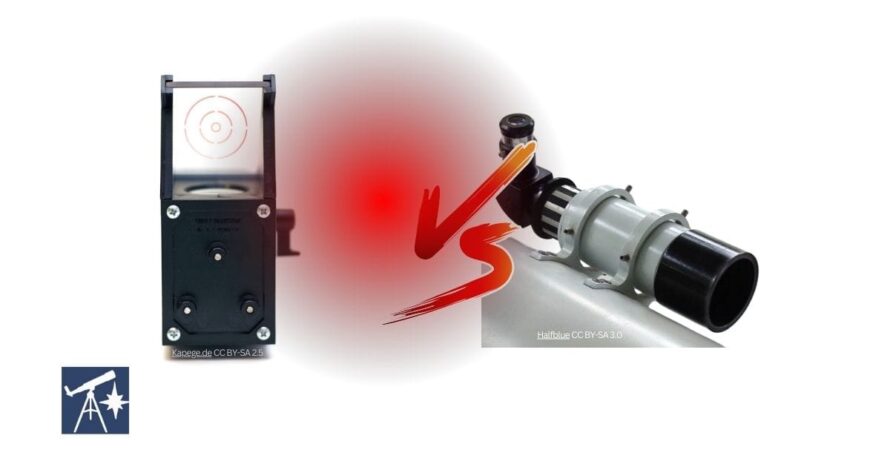If you’re new to stargazing or looking to upgrade your equipment, you may be wondering whether to get a red dot finder.

The main difference between red dot and optical finder scopes
- Optical finderscopes use lenses and are miniature telescopes often sold as the standard finderscope with telescopes.
- Red-dot finders are an accessory that uses an LED to project a small red dot onto the night sky view seen through the finderscope.
What a Red Dot finder looks like…
Apart from the Telrad shown above, red dot sights for telescopes can look like the following.

Astromania Finderscope Starpointer Available at Amazon
Optical and Red Dot finders compared – Table
It comes down to preferences. This table compares the two for your quick answer:
| Optical Finderscope | Red-Dot Finderscope | |
|---|---|---|
| Magnification | Yes | No |
| Target acquisition | Moderate | Fast |
| Field of view | Narrower than Red Dot | Wider than Optical |
| Battery requirement | None | Yes |
| Cost | Inexpensive to expensive | Inexpensive to moderate |
| Durability | Good — no electronic parts | Electronics, which can fail |
As well as this, each has its downsides and there are different designs within each type of these finderscopes, that you should know about…
Optical finderscopes
The different types of optical finderscopes include straight-through, angled, and right-angle finderscopes.
Straight-through finderscopes are the most common type and are mounted on top of the telescope. They are typically the most affordable. I wouldn’t say they are the easiest to use, because the straight-through finderscope displays the image upside down, meaning you have to stretch your brain a little until you get used to this inverted view. As well, you need to contort yourself to get your eye aligned to look through the finderscope.
Much better for comfort is the angled and right-angle optical finderscopes. And both use prisms or mirrors to correct the image orientation, so the image appears right-side up.
Angled finderscopes are similar to straight-through finderscopes, but they are angled at 45 degrees, making them easier to use for individuals with neck or back problems. These types of finderscopes tend to be more expensive than straight-through finderscopes.
Right-angle finderscopes are similar to angled finderscopes in that they are mounted at a 90-degree angle to the telescope. These types of finderscopes are often preferred by individuals who prefer to observe objects while seated, as they allow for a more comfortable viewing angle. Right-angle finderscopes generally cost more than the other mentioned optical finderscopes.
What is a Red Dot finderscope
Red-dot finderscopes project a small red dot, powered by a red LED, onto the night sky viewed through the finderscope. The red dot allows you to easily align and point the main telescope at the targeted object.
The Red Dot Finder is a zero magnification pointing tool that uses a coated glass window to superimpose the image of a small red dot onto the night sky.
www.skywatchertelescope.com
While red-dot finderscopes are lightweight, easy to use, and require minimal alignment, they are problematic in bright light conditions and for users with color blindness who see red as a shade that might blend with the background.
Different types of Red Dot finderscopes
There are primarily two types of Red Dot finderscopes – fixed and variable.
Fixed Red Dot finderscopes have a single dot that remains in the center of the viewing area. They are usually less expensive and simpler to use than the variable type. Fixed Red Dot finderscopes are preferred by beginners and those who do not require a lot of precision in their observations.
Variable Red Dot finderscopes offer different reticle options in that the user can select a dual circle, a green dot, or maybe choose between a big dot, crosshair, or crosshair with a dot, depending on the design. They are more expensive than fixed Red Dot finderscopes but offer more precision and flexibility in aiming. Variable Red Dot finderscopes are preferred by advanced observers who want to observe faint objects or those who require a high degree of precision in their observations.
Finderscope top brands
Here are some of the top brands of finderscopes:
- Celestron: Celestron is a well-known brand in the astronomy industry, and they offer a range of high-quality finderscopes.
- Orion: Orion is another popular brand that offers a range of finderscopes.
- Telrad: Telrad is a well-respected reflex design in finderscopes.
- Sky-Watcher: Sky-Watcher is a brand that offers a range of high-quality Red Dot finderscopes.
How they compare in price and quality
| Price Range | Quality | |
|---|---|---|
| Celestron | $30–$100 | Good |
| Orion | $40–$120 | Good |
| Telrad | $40–$50 | Excellent |
| Sky-Watcher | $35–$70 | Good |
The following is the Celestron StarPointer Red Dot Finderscope (affiliate link), available at Amazon.
Is a Red Dot Finderscope better than an Optical Finderscope?
Many backyard astronomers prefer a Red Dot Finderscope with the red dot easily seen on a dark night, making it easy to align the telescope. It comes down to your preference. In forums, you’ll see the Telrad talked about as a popular choice in finderscope. This is another design of finderscope – a reflex.
Check out the finderscopes at High Point Scientific, they have the Telrad as well!
Optical finderscopes offer a magnified view of the sky, which helps with locating target objects. Red Dot finderscopes offer no magnification. They mean faster target acquisition and give a wider field of view, but they require a battery to operate and can be problematic for color-blind users.
Both vary in price depending on the design and brand. Make your choice based on what works for you, your budget, and how you intend to use it.

